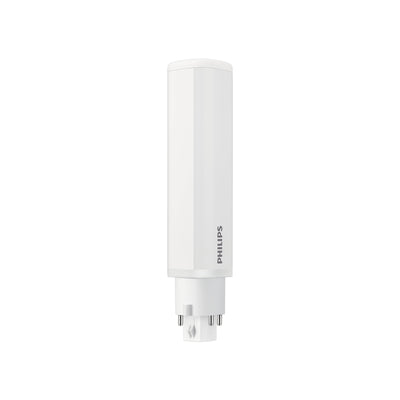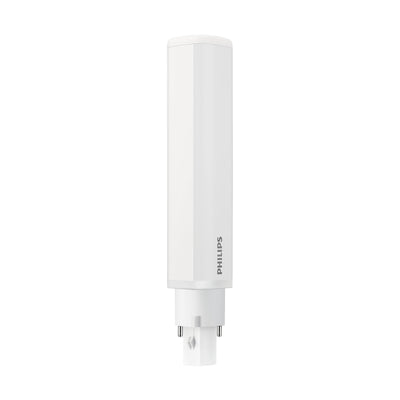
PL Lamps
PL lamps, also known as compact fluorescent lamps (CFLs) with a plug-in base, have been a widely used light source in functional environments for decades. They are often found in downlights, wall fixtures, and ceiling fixtures within offices, shops, hospitals, and public buildings. Their compact size and efficient light distribution made them a popular choice for general lighting.
With recent changes in European regulations, the production and import of many traditional PL lamps are restricted. This has led to a growing focus on more sustainable LED alternatives. This development not only responds to the regulations but also offers significant benefits for users in terms of energy consumption and lifespan.
-
 3,5W - 470 lm - 4000K - Dimbaar91
3,5W - 470 lm - 4000K - Dimbaar91 -

Philips Philips CorePro LED PLC 6.5W 4P G24q-2 bulb 700 lumen 3000K
3,5W - 470 lm - 4000K - Dimbaar170 -

Philips Philips CorePro LED PLC G24q-1, 5.5W 4000K 660 lumen, cool white, IP20, non-dimmable, 120° beam
3,5W - 470 lm - 4000K - Dimbaar125 -

Philips Philips CorePro LED PLC 8.9W 3000K g24d-3 energy-efficient light bulb
3,5W - 470 lm - 4000K - Dimbaar179 -

Philips Philips CorePro LED PLC 6.9W 3000K G24d-2 lamp with 700 lumen and 120° beam
3,5W - 470 lm - 4000K - Dimbaar102 -

Philips Philips CorePro LED PLS 5W 840 2P G23, 4000K cool white, 550 lumen
3,5W - 470 lm - 4000K - Dimbaar136 -

Philips Philips CorePro LED PLS 5W G23 bulb, 3000K, 520 lumen, energy-efficient, 120° beam angle, 30000 hr lifespan
3,5W - 470 lm - 4000K - Dimbaar113 -

Philips Philips CorePro LED PL-S 3.5W 3000K G23 bulb with 360 lumen and 120-degree beam angle
3,5W - 470 lm - 4000K - Dimbaar68 -

Philips Philips CorePro LED PLL 24W 840 4P tube light with 4000K and 3400 lumens
3,5W - 470 lm - 4000K - Dimbaar182 -

Philips Philips CorePro LED PLL 24W 830 2G11 3000K 3200 lumen energy-efficient lighting
3,5W - 470 lm - 4000K - Dimbaar182 -

Philips Philips CorePro LED PLL 16.5W 2G11 4000K cool white lighting
3,5W - 470 lm - 4000K - Dimbaar125 -

Philips Philips CorePro LED PLL EM 16.5W 3000K 2G11 base 2000 lumen
3,5W - 470 lm - 4000K - Dimbaar136
Overview of PL Lamps and their Bases
PL lamps come in various versions, each with its own base. The distinction lies mainly in the number of pins and the specific design of the base, which determines compatibility with the fixture.
| Type of PL Lamp | Number of Pins | Base Type | Typical Application |
|---|---|---|---|
| PL-S | 2 or 4 | G23 (2-pin) or 2G7 (4-pin) | Small downlights, hallways, emergency lighting |
| PL-C | 2 or 4 | G24d (2-pin) or G24q (4-pin) | General lighting, larger downlights in offices |
| PL-L | 4 | 2G11 | Long fixtures, larger spaces, linear lighting |
When choosing a replacement, always pay close attention to the base. An incorrect base will not fit in the fixture and will not function.
Why Switching to LED PL Lamps Offers Benefits
Switching from traditional PL lamps to LED versions is a logical step for many businesses and building managers. This transition is not only a response to changing regulations but also offers tangible operational advantages.
- Substantial energy savings: LED PL lamps consume significantly less energy than their fluorescent counterparts, with savings of up to 60% or more. This means a direct and noticeable reduction in energy costs, leading to considerable long-term savings.
- A much longer lifespan: Whereas traditional PL lamps have a lifespan of about 10,000 to 20,000 operating hours, LED PL lamps easily last 30,000 to 50,000 operating hours. This significantly reduces the frequency of lamp replacements, resulting in lower maintenance costs and less disruption to business operations.
- Instant full brightness: LED PL lamps provide full light output immediately upon being switched on, without the start-up time typical of fluorescent lamps. This contributes to a more comfortable and instantly functional lighting experience.
- Environmentally conscious choice: Traditional PL lamps contain mercury, a substance that can be harmful to the environment and health if the lamp breaks. LED PL lamps are mercury-free and much easier to recycle, making them a more sustainable option.
Selecting a Suitable LED PL Replacement
The transition to LED PL lamps requires attention to compatibility and installation method. It is important to choose the right LED variant that fits your current fixture and electrical installation.
Compatibility and Installation
PL lamps work with a ballast that regulates the current. For LED PL lamps, there are two main types that determine how you install the lamp:
| Method | Type of LED PL | Installation | Suitable for | Point of Attention |
|---|---|---|---|---|
| Plug-and-play | 'Direct Replacement' (Type A) | Directly into an existing fixture with a compatible ballast. | Fixtures with electronic or magnetic ballasts. | Check ballast compatibility. Sometimes an LED starter is needed. |
| Ballast bypass | 'Mains Voltage' (Type B) | Remove the ballast and connect directly to mains voltage. | Fixtures where the ballast can be removed. | Requires rewiring by a professional. |
For installers: always check if the existing ballast is compatible with the "plug-and-play" LED variant. When in doubt, or for maximum efficiency, it is recommended to remove the ballast and connect the lamp directly to the mains voltage. This simplifies long-term installation and prevents issues with a potentially failing ballast.
Important Specifications to Look For
When choosing an LED PL lamp, in addition to the base and installation method, the light quality and brightness are also important:
- Lumen (light output): This indicates how much light the lamp produces. Compare the lumen value of the LED replacement with your current PL lamp to achieve a similar or better light output.
-
Light Colour (Kelvin): Expressed in Kelvin (K), this determines the ambiance of the light. Common options are:
- Warm White (2700K-3000K): Suitable for spaces where a warm, inviting atmosphere is desired, such as restaurants or reception areas.
- Cool White (4000K): Often used in offices, kitchens, and hallways for bright, neutral lighting.
- Daylight White (6000K-6500K): This very bright light colour is functional for workspaces where concentration and good visibility are important, such as warehouses or production areas.
- Colour Rendering Index (CRI): This value, on a scale of 0 to 100, indicates how accurately colours are rendered. For most applications, a CRI of 80 or higher is recommended to ensure that objects and surfaces look realistic.
Recycling Old PL Lamps
Because traditional PL lamps contain mercury, they must not be disposed of with regular household waste. Hand these lamps in at a municipal collection point for small chemical waste or at special collection points in hardware or electronics stores. This ensures that the materials are processed and recycled responsibly.










